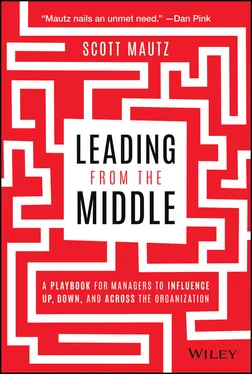Leading from the middle can most certainly take a physical toll. But you can't take care of everything, or anything, if you don't prioritize taking care of yourself first. That's straight from the playbook of life, let alone this playbook.
Here are a few more reorienting insights to help reduce the physical drains.
1. Know that while you can impact everything, you're not responsible for everything.Period.
2. You're in the middle but aren't at the epicenter of every earthquake.Not every fire drill needs to be answered. Everyone else's urgent is not your urgent. And acting like it is isn't a good place to be. To illustrate, I can say my most ineffective stint as a middle manager occurred in a role where fire drills constantly sprang up. Instead of filtering them, I fed them, creating a flurry of activity that distracted my organization from more important priorities. Learn from my mistake.
To push back on repeated urgent requests, come from a place of accountability. Meaning, let the requestor know you can't accommodate because of the impact it would have on other critical priorities. Give them a different “yes” by empathetically offering alternatives to you dropping everything. Show them support in other ways.
3. Your physical health and succeeding at work aren't mutually exclusive.Step out of the grind long enough to realize that. Put your health on a pedestal, the investment will pay dividends personally and professionally. For instance, I find my work gets better the more time I take to work on my health.
4. Be bound by boundaries.While leading from the middle requires a strong presence everywhere within your scope of responsibility, it doesn't mean your work should cross over into every aspect up, down, and across the organization, and of your life. Boundaries are more important in the middle than anywhere else in an organization because more people have access to you, and so you're disproportionately exposed to stress triggers.
First, give yourself permission to set boundaries. Then, take the time to define what your boundaries are (what you'll engage in, when, within what parameters) and clearly communicate them to others. Pick low‐risk situations to practice saying “no” and commit to delegating more. Create structures and processes to help control work and time flow (like agendas), and stick to them. Finally, identify what needs to change to enable your boundaries (like new habits at home that would help keep work at work).
It's hard not to get caught up in the emotional strain of being in the middle. But remember that you're part of a pattern. It's not personal, it's a reflection of the position itself.
Here are reframes that speak to the nastiest of the emotional toll—the sense of isolation and being undervalued.
1. It might feel like you're on an island at times, but that can be a good thing.You're actually a safe haven for workers to express frustrations, voice concerns, share ideas, and take risks without fear of undue punishment. I once took my team to an art studio where each member painted a picture of an island, as a symbolic gesture that this team would be an oasis, unlike any other team in the company, a safe‐haven and enjoyable place to be, free from typical company nonsense.
At the same time, of course, you also connect to the rest of the organization, and connect disparate parts of the organization to each other, by building bridges.
2. You're not alone, you're on loan, a ninja in the middle, there to make the engine hum.You're there until your talents elevate you upward in the company or across to something you're more interested in.
3. Senior managers might not always acknowledge your value, but everyone else does.Recall the earlier Boston Consulting Group research—you're more appreciated than you realize.
4. While at times it might feel like you're not in control of much of anything, you're always in control of your attitude.Just as important, you may have become numb to the amount of daily influence you have in the countless tradeoffs and decisions you make every day. No one in an organization makes more decisions that matter each day than those who lead up, down, and across.
We talked earlier about the wide variety of roles someone who leads from the middle must take on. My research reveals there are 21 distinct roles middle managers must play. Think of what follows as a 21‐gun salute. I'll honor each role with a brief description and then give you plays for each one (I call them “Role Plays”), in the form of the single best piece of advice to succeed with each hat you wear.
A core role of the middle manager is to receive the vision and strategies from above and ensure everyone down (and often across) understands that direction.
The Role Play: Key here is to know that you're not just an explainer, you're an expander. Always add your perspective to upper management directives and help employees understand how their work specifically fits into the broader mission. Give a chance for employees to react to the direction and express concerns (knowing that resistance is often just a cover for wanting to be heard).
Just ensuring everyone understands the direction isn't enough, of course. Middle managers must also convert those visions and strategies into concrete and organized business plans and tactics.
The Role Play: It's critical to do so with an eye on the three c 's: competition, capacity, and the customer. Too often I've seen well‐intended middle managers develop plans in a silo. They don't consider key competitors' potential reactions, they ignore capacity and try to do far too much while not making enough choices (the easy thing is to do everything), or they fail to truly understand the customer's needs and habits when developing the plans and tactics.
The best in the middle aren't just tacticians, they also play an active strategic role. No one is closer to changing market dynamics, has more access to new information coming in, or has a closer pulse on what the organization would rally behind. So often I hear, “Strategic thinking is the last thing I have time for” from middle managers. But it should be the first thing you make time for as it impacts every other role you play.
The Role Play: Toggle between the three strategy jobs to do (many mid‐level managers stop at the first job). First, cascade top‐down strategies to fully implement top management's intentions. Start by fully understanding the strategies, then share perspective to gain commitment when converting the strategies into operational tactics. Second, shape top‐down strategies in advance by analyzing information available to you, assessing opportunities and threats, and sharing your perspective and recommendations with decision makers above you. Finally, champion “on the ground” strategies, ones that you and your team create and implement given what you know by being closest to customers, consumers, and competitors. This last strategy job to do is the most often missed or underserved, which is a travesty, as one study showed that a whopping 80 percent of strategic projects initiated by top management failed while 80 percent of those initiated by mid‐level managers succeeded. 11
Almost by definition, if you manage up, down, and across, you're the one who makes things happen. If it is to be, it's up to thee. It's easy though to get caught up triggering a flurry of activity that's not necessarily the right activity.
Читать дальше












